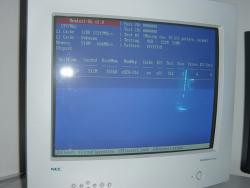2003 Power Supply Roundup Part II: Better Faster Cheaper
by Kristopher Kubicki on July 31, 2003 1:58 PM EST- Posted in
- Cases/Cooling/PSUs
This is kind of a unique test we have worked on for a while. One of the more important qualities of a power supply is to make sure it does not produce harmful interference to the components. Perhaps the most sensitive of these components is the memory (video card, RAM, and CPU cache), which is just millions of little transistors locked in an on or off position, held in place only by a delicate balance of electricity.
The driving theory behind ECC memory is that it corrects errors that occur in memory. Perhaps a transistor is faulty and flipped for the wrong reason, or a faint electrical signal pulled a transistor into the incorrect position. While researching this review and others, we have noticed the largest factor for incorrect memory blocks is faulty power supplies.
How it works:
We started off by modifying MemTest86. We bumped the delay between tests up to several hours, rather than seconds. MemTests86 works by writing various patterns into the memory. After our programmed delay of six hours, the program goes back over the memory and analyzes how many of those bits were flipped out of the original pattern. Both the memory and motherboard used passed the unmodified MemTest86 without any problems.
Not only is this a good measure of shielding on the PSU, but also a good measure of shielding on the motherboard and memory. However, we used the same motherboard and memory for the entire test. This way we assure that the small amount of interference coming off the motherboard is consistent with each power supply. Unfortunately, it took 6 hours to run this test and we ran it three times for each supply to assure accuracy. On the next page is a table showing the trial data.











70 Comments
View All Comments
Anonymous User - Saturday, August 2, 2003 - link
#11, yes P=IxV, but the power ratings in the table were obviously taken from manufacturers' data rather than actual measurements, which is why when any power rating for any of the positive voltages is divided by that voltage, the quotient exactly equals an integer. That would not be a problem if all manufacturers applied identical standards to their specifications, but many computer users have learned that this isn't the case.Anonymous User - Saturday, August 2, 2003 - link
Perhaps you could include a Q-Tec PSU in the next review? They retail here in Sweden at about 60% of the price of corresponding Enermax and other high quality units, so assuming they aren't totally lousy they're very cheap.Anonymous User - Friday, August 1, 2003 - link
I agree with #15. Definitely take a look at the PC Power and Cooling 400w Silencer PSU. I own two of these units and they're very high quality with reasonably low noise.Anonymous User - Friday, August 1, 2003 - link
Enlight power supplies are always being excluded from these PSU comparsions. I have a Enlight 360W PSU and it's very stable and very quiet. Test some Enlight PSUs!Anonymous User - Friday, August 1, 2003 - link
I appreciated the comments concerning AMD users, but what I really need is some sort of guidance on AMD processor speed vs combined power or 3.3V rail current for upgrading older systems. Many older cases have limited power supplies and I'm trying to figure out the fastest processor I can install and still have reliable operation. Example: A 300 watt supply with 25A of 3.3V can only support up to a Athlon 1600+ on an ECS K7S5A Pro or a 350 watt with a combined power of 200W can support up to 2200+. Oh, and forget that old 250 watt power supply altogether. I need something like that... yeah, I know: your mileage may vary, void where prohibited by law, no watts were endangered in the making of this article.....:-)Anonymous User - Friday, August 1, 2003 - link
Next time you guys might want to check out the PC P&C Silencer 400. It's built just as heavily as the Turbo Cool but with a quieter fan.Anonymous User - Friday, August 1, 2003 - link
Hey guys, im sure 1 or 2 of you resistorheads are an ee or will soon be one.. ripple and noise are only part of a good pwr supply.. we need the facts... how many watts do these power supplies really put out. how do they respond with a big load.. will they take an overload.. how well are they protected...thats what i wanna read aboutMIDIman - Friday, August 1, 2003 - link
WOW - excellent review. I'm getting a zalman for my silent box.Nice to see you guys pumping out articles quickly again! Thanks!
idenyit - Friday, August 1, 2003 - link
hey just wondering the allied A400ATX hows that compare with the B400ATX thats offered on newegg? any differences?Anonymous User - Friday, August 1, 2003 - link
#10, doesnt P=IV? The Power and Voltage measurements were given.